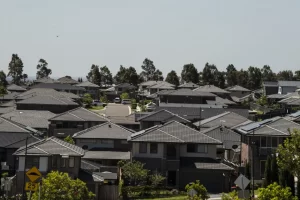By all accounts, Australia’s housing market has a tough act to follow in 2022. Dwelling values soared 22.2 per cent nationally this year – the largest annual increase since 1989, fuelled by ultra-low interest rates, high household savings, government stimulus and relatively low listings.
Sydney dwelling prices rocketed by 25.8 per cent and Melbourne by 16.3 per cent. Over the same period, the total estimated value of the country’s residential real estate ballooned by $2.2 trillion to $9.4 trillion – a record high, data from CoreLogic shows.
But these astronomical growth rates are about to come to an end as the market forces that powered the housing boom lose their strength.
“If you’re expecting housing values to rise by a similar amount next year as they did this year, I think you’re going to be disappointed,” said Tim Lawless, CoreLogic research director.
“I think the growth rate next year will be remarkably low – somewhere between 5 per cent and 7 per cent nationally, maybe even less than that because I think the market will slow down so sharply.”
Mr Lawless said the slowdown in the housing market, in particular in Sydney and Melbourne, would be triggered by a combination of factors, such as poor affordability, a surge in listings and tightening credit policy.
“I think affordability is probably going to be the most significant factor slowing the market down,” he said.
“Housing values rose by more than 20 per cent nationally this year against this backdrop of very modest income growth, which simply means that more and more people have been blocked from accessing the marketplace.”
ANZ senior economist Felicity Emmett said higher mortgage rates would be the biggest drag on prices in the next 12 months.
“I think the prospect of higher mortgage rates is probably playing into some people’s thinking around the housing market,” she said.
“That’s going to take some steam out of the housing market, along with the macro prudential tightening from APRA. But I think the interest rate story is the strongest one at the moment.”
Ms Emmett said the frenetic activity in the past year was likely to dissipate as listings flooded the market.
“I think the dynamics will change a little bit and I expect to see a more balanced market,” she said.
Long-term average
“Our expectation is that prices will continue to rise and, at least in the first half of the year, there’ll be much more moderate price gains than what we saw through 2020.”
ANZ is forecasting Sydney dwelling prices to rise by just 6 per cent in the next 12 months, Melbourne to grow by 7 per cent and national growth to be 6 per cent – substantially lower than this year, but still above their long-term average performance.
In the past five years, Sydney’s dwelling prices had risen by 5.4 per cent each year on average. Melbourne had been growing by 4.6 per cent annually and by 5.2 per cent nationally each year in the past five years, the CoreLogic data shows.
BIS Oxford Economics economist Maree Kilroy said shifting buyer preferences and population growth were also likely to affect house prices in the year ahead.
“Through the pandemic, people have saved more, and they have been diverting a lot of their funds towards housing. But as things start to wind back, and we’ll return to a more pre-pandemic environment, people will start travelling again and returned expats will go back overseas,” she said.
“So the stimulus, changed behaviours and spending during the pandemic are not permanent and these will unwind. By how much and how quickly it unwinds is a risk for the housing sector.”
Potential game changers
Mr Lawless said in addition to COVID-19, tighter credit policy and the economy were among the possible game changers for the housing market.
“If we do see any further restrictions introduced, especially around property inspections, we know that that would have a negative impact on housing activity,” he said.
“If there are further changes to credit policy, such as further tightening, this would also slow price growth.”
While the improving economy bodes well for the housing market, it could also trigger an earlier-than-expected rate hike, Mr Lawless said.
Wage growth
“It looks like the economy will probably strengthen faster than the earlier forecasts from, say, the RBA or Treasury based on the labour market figures we saw coming through last week, which were extremely strong, and this could potentially start to flow through to wage growth and higher inflation,” he said.
“A stronger economy is obviously good news for Australia and the property market because it means more people are able to afford a mortgage.
“That’s also bad news, because it probably means there’ll be an earlier rate hike, so I think the trajectory of the economy is certainly going to be a wild card.”
On the bright side, if the border reopened and immigration resumed, this would immediately boost the rental market, Mr Lawless said.
“Any pick-up in migration will have the most immediate impact on rental demand, especially for apartments around Melbourne and Sydney,” he said.
“So those markets could benefit from the influx of foreign students, foreign visitors as well as overseas migrants that are coming here permanently.”
The year of the smaller cities
Mr Lawless said as the Sydney and Melbourne housing markets eased, the smaller capitals were likely to take the lead.
“I think next year will be the year of the smaller cities,” he said.
“We’ve been through a couple of cycles now where the largest cities – Sydney and Melbourne – dominated the growth cycles in housing, which has created pretty severe affordability challenges and some social equity [issues] as well.
“The smaller cities such as Brisbane and Adelaide, where prices have not grown to a similar height, will have the affordability advantage to attract homebuyers who now have the option to be based anywhere due to flexible working arrangements.”
Unlike Sydney and Melbourne where listings had soared to records in the past few weeks, stock levels in the smaller capitals remained low, said Mr Lawless.
“We’re still seeing overall stock at remarkably low levels in Brisbane and Adelaide,” he said. “Listings are still around 33 per cent and 32 per cent below the five-year average respectively, so they haven’t shown much evidence of normalising at all.”
This article is from Australian Financial Review, please click the following link for the original article: https://www.afr.com/property/residential/what-the-housing-market-could-look-like-in-2022-20211220-p59j08




